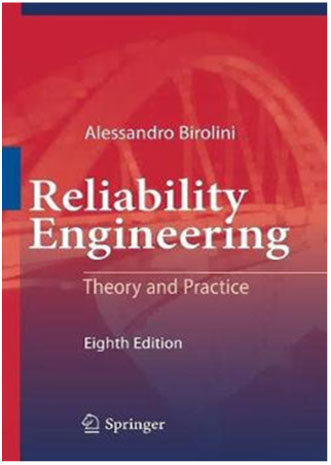
This book is currently in its Eighth edition and presents, in a very comprehensive way, concepts of reliability engineering. The current edition includes a presentation of some state-of-the-art aspects that are becoming mainstream now in risk and reliability engineering studies. The book presents in a very balanced way theory and aspects of practical implementation, offering to the reader a reference point for the most important and widely used methods. It is organised in eight chapters and includes an extensive appendix.
The first chapter presents the basic concepts of RAMS (Reliability, Availability, Maintainability and Safety) analysis introducing the appropriate terminology for reliability, failure, maintenance, availability, safety and risk, which are relevant to subsequent chapters of the book. The link between quality and reliability is also key in modern complex engineering systems.
Chapter 2 deals with reliability analysis during the design phase discussing failure rates modelling and presenting in detail the calculation process of the reliability of series, parallel and mixed systems. The concepts of redundancy and reliability allocation from a system to its components are introduced. Failure mode analysis is also presented in a practical way. Chapter 3 discusses qualification tests, primarily for electrical components and assemblies. Good examples for qualification tests are presented, and an indicative procedure for failure analysis from a user’s point of view is also included.
Chapter 4 discusses maintainability, touching upon a number of critical aspects introducing key concepts such as partitioning, fault detection and localisation and logistic support. The chapter also explains the relevant concept of mean time to repair, followed by spare parts provisioning and finally strategies that inform maintenance decisions. Having presented key concepts, Chapter 5 offers guidelines with respect to reliability, maintainability and software quality with a view to highlighting the key parameters that can effectively inform design.
Chapter 6 is probably the most fundamental chapter of this book, dealing with reliability and availability of repairable systems. Concepts are initially presented from a single component point of view and gradually builds on systems in series and parallel, which includes detailed discussion on redundancy also introducing the time element. The concept of k-out-of-n systems is also presented for calculations of systems with identical elements and warm redundancy. It should be noted that systems with complex structures are very well presented in this book, constituting it as a key reference. The chapter ends with a link to risk management concepts, bridging the gap between organisational objectives and operational management.
Chapter 7 starts by discussing statistical quality control and RAMS tests with the aim to estimate and demonstrate availability and failure rates as well as mean times to repair. The important concepts of goodness-of-fit tests for statistical data processing and trend tests for data are also included in detail.
The final chapter of the book discusses the production phase of components and assemblies and more specifically testing and screening, also introducing economic aspects relevant to reliability provisions.
The appendices of the book are also very helpful, especially the appropriate list of terms and definitions, review of RAMS standards, basic probability and stochastic processes theory and mathematical statistics, making this a stand-alone source of information with limited requirement to external references.
In summary, this is an excellent book that can stand as a reference point for scientists and practitioners working on reliability engineering as it presents in a comprehensive and understandable way both basic and advanced relevant concepts.


